Themed collection Editors' Collection: Phthalocyanines

Metal phthalocyanines: thin-film formation, microstructure, and physical properties
Metal phthalocyanines (MPcs) are an abundant class of conjugated small molecules comprising and their integration into thin films is critial for the proper function of next generation applications.
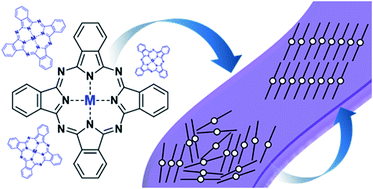
RSC Adv., 2021,11, 21716-21737
https://doi.org/10.1039/D1RA03853B
Evaluation of histone deacetylase inhibitor substituted zinc and indium phthalocyanines for chemo- and photodynamic therapy
3-Hydroxypyridin-2-thione bearing zinc and indium phthalocyanine derivatives, as photosensitizer agents have been synthesized and evaluated for their anti-cancer efficacy on two breast cancer cell lines, MDA-MB-231 and MCF-7 as well as a human endothelial cell line, HUVEC.

RSC Adv., 2021,11, 34963-34978
https://doi.org/10.1039/D1RA05404J
Near-infrared and metal-free tetra(butylamino)phthalocyanine nanoparticles for dual modal cancer phototherapy
Two new HSA-involved tetra(butylamino)phthalocyanine composite nanoparticles, as highly efficient dual-phototherapy agents upon a single NIR laser irradiation, were reported.
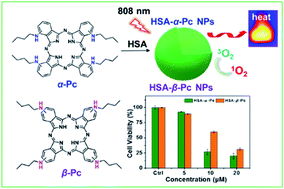
RSC Adv., 2020,10, 25958-25965
https://doi.org/10.1039/D0RA03898A
Impact of photosensitizer orientation on the distance dependent photocatalytic activity in zinc phthalocyanine–nanoporous gold hybrid systems
The distance dependency of the photocatalytic activity in zinc phthalocyanine–nanoporous gold hybrid systems was investigated revealing the importance of photosensitizer orientation in novel hybrid-based photocatalysts.
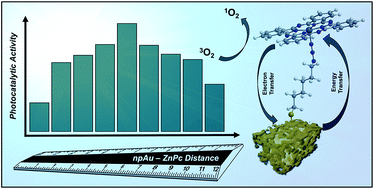
RSC Adv., 2020,10, 23203-23211
https://doi.org/10.1039/D0RA03891A
Single-molecular phosphorus phthalocyanine-based near-infrared-II nanoagent for photothermal antitumor therapy
A molecular phosphorus phthalocyanine (P-Pc)-based nanoagent P-Pc-HSA, which can be a highly efficient NIR-II antitumor agent, is reported.

RSC Adv., 2020,10, 22656-22662
https://doi.org/10.1039/D0RA03530K
Elucidating π–π interaction-induced extension effect in sandwich phthalocyaninato compounds
π–π interaction-linked extension in the perpendicular direction to the monomers and corresponding effect on nonlinear optic properties have been clearly disclosed over the multiple-decker sandwich-type phthalocyaninato metal compounds.

RSC Adv., 2020,10, 317-322
https://doi.org/10.1039/C9RA07847A
Photocatalytic coatings based on a zinc(II) phthalocyanine derivative immobilized on nanoporous gold leafs with various pore sizes
A series of hybrid materials consisting of a zinc(II) phthalocyanine derivative immobilized on nanoporous gold leafs with various pore sizes was prepared and investigated regarding its singlet oxygen sensitization activity.
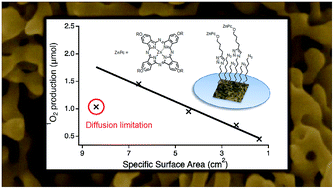
RSC Adv., 2020,10, 53-59
https://doi.org/10.1039/C9RA08841E
Magnetic properties of on-surface synthesized single-ion molecular magnets
We perform on-surface synthesis of single-ion molecular magnets on an Ag(111) surface and characterize their morphology, chemistry, and magnetism.

RSC Adv., 2019,9, 34421-34429
https://doi.org/10.1039/C9RA06803A
Electron delocalization in single-layer phthalocyanine-based covalent organic frameworks: a first principle study
A series of single-layer phthalocyanine-based covalent-organic frameworks (COFs) are shown to possess tunable delocalized electronic states which are attractive for optoelectronic applications.
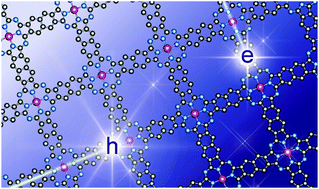
RSC Adv., 2019,9, 29440-29447
https://doi.org/10.1039/C9RA05159G
Metal phthalocyanine organic thin-film transistors: changes in electrical performance and stability in response to temperature and environment
A series of metal phthalocyanine based organic thin film transistors were evaluated and their responses to changes in temperature and environmental was determined: the choice of central atom makes a difference.
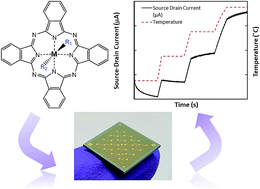
RSC Adv., 2019,9, 21478-21485
https://doi.org/10.1039/C9RA03648B
Synthesis and biological evaluation of an epidermal growth factor receptor-targeted peptide-conjugated phthalocyanine-based photosensitiser
A peptide-conjugated zinc(II) phthalocyanine has been prepared which can selectively bind to the epidermal growth factor receptor of cancer cells and induce high cytotoxicity upon illumination.
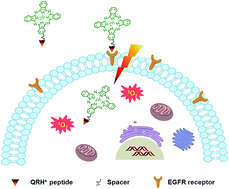
RSC Adv., 2019,9, 20652-20662
https://doi.org/10.1039/C9RA03911B
Nonlinear optical behavior of n-tuple decker phthalocyanines at the nanosecond regime: investigation of change in mechanisms
Rare-earth n-tuple decker phthalocyanine complexes exhibit superior optical limiting properties than the neutral double-decker derivatives, with the normalized transmittance reduced to about 80%.

RSC Adv., 2019,9, 16223-16234
https://doi.org/10.1039/C9RA01836K
Poly(arylene ether)s with aromatic azo-coupled cobalt phthalocyanines in the side chain: synthesis, characterization and nonlinear optical and optical limiting properties
A novel poly(arylene ether) with azo-coupled cobalt phthalocyanine in the side chain was prepared by 1,2-benzodinitrile, anhydrous cobaltous chloride and a novel azobenzene-containing poly(aryl ether).
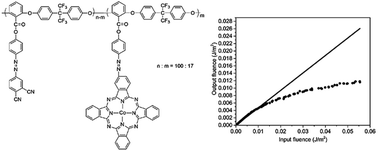
RSC Adv., 2019,9, 9253-9259
https://doi.org/10.1039/C8RA07661H
Reduced graphene oxide-induced crystallization of CuPc interfacial layer for high performance of perovskite photodetectors
TS-CuPc/rGO nanocomposite thin films were synthesized and applied as an interfacial layer for high-performance perovskite-based photodiodes.
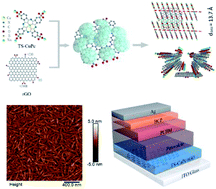
RSC Adv., 2019,9, 3800-3808
https://doi.org/10.1039/C8RA08864K
P and N type copper phthalocyanines as effective semiconductors in organic thin-film transistor based DNA biosensors at elevated temperatures
This study illustrates the use of an N-type semiconductor, in both temperature and DNA sensors and further elucidates the mechanism of DNA sensing in OTFTs.
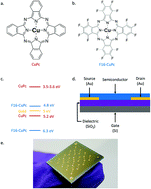
RSC Adv., 2019,9, 2133-2142
https://doi.org/10.1039/C8RA08829B
Tailoring of the chlorine sensing properties of substituted metal phthalocyanines non-covalently anchored on single-walled carbon nanotubes
Schematic view of the interaction between Cl2 and S1/S2 hybrid sensor.
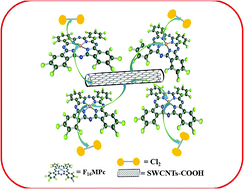
RSC Adv., 2018,8, 32719-32730
https://doi.org/10.1039/C8RA05529G
Simple, selective and fast detection of acrylamide based on glutathione S-transferase
Acrylamide (AA) is a toxic compound formed in thermally prepared foods by Maillard reaction.

RSC Adv., 2018,8, 23931-23936
https://doi.org/10.1039/C8RA02252F
Control of the molecular packing of chloroboron(III) and fluoroboron(III) subnaphthalocyanines by designing peripheral substituents
Dipolar subnaphthalocyanines with alkynyl groups and a B–F moiety are packed in hexagonal columns.
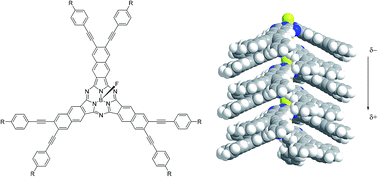
RSC Adv., 2017,7, 54235-54245
https://doi.org/10.1039/C7RA11104E
Combinatorial experimental and DFT theoretical investigation over the formation mechanism of a binuclear phthalocyanine dimer
Herein, a density functional calculation method was used to explore the formation mechanism of a metal-free, homobinuclear phthalocyanine dimer.

RSC Adv., 2017,7, 53043-53047
https://doi.org/10.1039/C7RA10678E
Synthesis and evaluation of a tetra[6,7]quinoxalinoporphyrazine-based near infrared photosensitizer
We report a near infrared, water-soluble, functional and dendrimeric photosensitizer for photodynamic therapy.
![Graphical abstract: Synthesis and evaluation of a tetra[6,7]quinoxalinoporphyrazine-based near infrared photosensitizer](/en/Image/Get?imageInfo.ImageType=GA&imageInfo.ImageIdentifier.ManuscriptID=C7RA06348B&imageInfo.ImageIdentifier.Year=2017)
RSC Adv., 2017,7, 50555-50561
https://doi.org/10.1039/C7RA06348B
Synthesis and characterization of fluorophthalocyanines bearing four 2-(2-thienyl)ethoxy moieties: from the optimization of the fluorine substitution to chemosensing
Tuning of the electron-donating/withdrawing balance in phthalocyanine complexes.
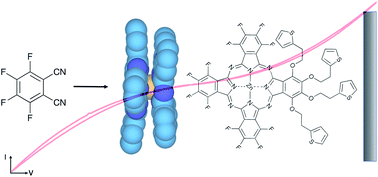
RSC Adv., 2017,7, 41272-41281
https://doi.org/10.1039/C7RA05325H
Photodynamic antimicrobial chemotherapy with cationic phthalocyanines against Escherichia coli planktonic and biofilm cultures
Cationic phthalocyanines (Pcs) combine with photodynamic antimicrobial chemotherapy (PACT) presents excellent antibacterial activity to Gram-negative bacteria E. coli.
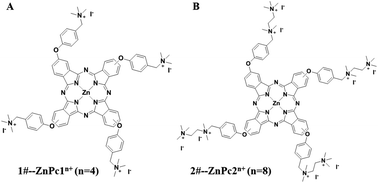
RSC Adv., 2017,7, 40734-40744
https://doi.org/10.1039/C7RA06073D
Subphthalocyanine-based porous organic polymers
The synthesis and photophysical properties of two subphthalocyanine-based porous organic polymers (SubPc-POPs) are reported.

RSC Adv., 2017,7, 29271-29274
https://doi.org/10.1039/C7RA05544G
Mechanistic study of NO oxidation on Cr–phthalocyanine: theoretical insight
A mechanistic investigation by DFT reveals that Cr–phthalocyanine is a promising catalyst for NO oxidation at low temperatures.
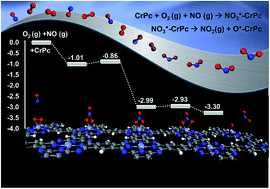
RSC Adv., 2017,7, 8858-8865
https://doi.org/10.1039/C7RA00525C
Anionic hexadeca-carboxylate tetrapyrazinoporphyrazine: synthesis and in vitro photodynamic studies of a water-soluble, non-aggregating photosensitizer
Photodynamic activity of hexadeca-carboxylate tetrapyrazinoporphyrazine is largely influenced by intracellular pH and its interaction with serum proteins.
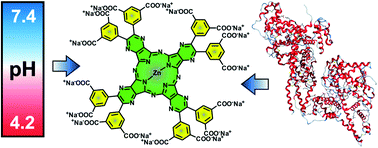
RSC Adv., 2016,6, 10064-10077
https://doi.org/10.1039/C5RA25881B
Synthesis and photophysical properties of phthalocyanines having calixpyrrole units
Calixpyrrole-armed metal phthalocyanine undergoes complexation by anions at the apical metal position upon light excitation.
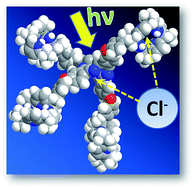
RSC Adv., 2015,5, 55901-55908
https://doi.org/10.1039/C5RA05830A
About this collection
This collection, guest edited by Associate Editor Dr Fabienne Dumoulin (Acıbadem Mehmet Ali Aydınlar University), features contributions on Phthalocyanines. These brightly coloured molecules belong to the porphyrinoids family, as do haemoglobin and chlorophyll. Their optical, magnetic, electronic (amongst others!) properties can be tailored by playing with the substitution and/or metalation pattern, with quasi-infinite combinations, giving the opportunity to perform enthralling structure-properties or structure-activities relationship analyses.
With an appropriate design, these fascinating compounds can act as photosensitisers for photodynamic therapy, take place in sensor devices, harvest light, catalyse, electro-catalyse or photo-catalyse either oxidation or reduction reactions. Their inclusion in materials such as MOFs and COFs and more generally in nanoscience enlarge again the possibilities to produce high-performance compounds and materials, should it be for pure fundamental research or more applied technologies.